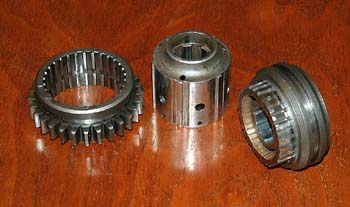|
Selector Shafts and Forks
|
- Place the first / second gear fork (5), third / fourth gear fork (6) and reverse selector (11) into place.
- Since it doesn’t matter which shaft is installed first, I will begin with reverse. To identify the shafts, the third / fourth
shaft has two side notches with a pin, reverse has one side notch and two top notices, while first / second had one side notch and
three top notches.
|
| Reverse Gear Selector Shaft |
- Slide the reverse selector shaft from the front of the casing, through the hole in the third / fourth gear fork (6), then
add the steady (9) and continue to side it through the reverse selector (11) and into the hole at the back of the casing.
- Turn and align the selector shaft until the pre-drilled hole aligns with the hole in the reverse selector (11) and lock in
place with the lock bolt.
- Align the steady with its pre-drilled hole and lock in place with the lock bolt.
- At the back of the casing, add the single ball that resides between the center selector shaft and reverse shaft. You might
want to add just a small amount of grease to hold the ball in place
|
|
| Third / Fourth Gear Selector Shaft |
- Slide the third / fourth selector shaft from the front of the casing, through the hole in the third / fourth fork (6), through
the steady (9) and then add the third / fourth gear selector (10) and continue to side it through the hole at the back of the casing.
- Turn and align the selector shaft until the pre-drilled hole aligns with the hole in the third / fourth selector fork (6) and lock
in place with the lock bolt.
- Align the third / fourth gear selector (10) to its pre-drilled hole and lock in place with the lock bolt.
- At the back of the casing, add the single ball that resides between the center selector shaft and first / second shaft.
|
|
| First / Second Gear Selector Shaft |
- Slide the first / second selector shaft from the front of the casing, add the stop (8), pass it through the hole in the third
/ fourth fork (6), and then through the first / second gear fork (5) and continue to side it through the hole at the back of the casing.
- Turn and align the selector shaft until the pre-drilled hole aligns with the hole in the first / second selector fork (5) and lock
in place with the lock bolt.
- Align the stop (8) to its pre-drilled hole and lock in place with the lock bolt.
|
|
- Finally, you need to add the securing wire to each of the lock bolts.
|
| At this time it is possible to test the sliding hubs and striking dogs, however it will take a fair amount of pressure to push the gear
selector forks (5 & 6). |




